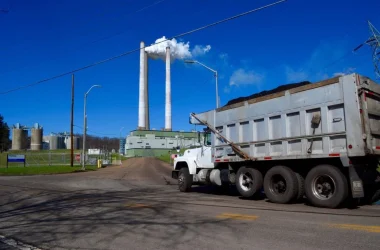By FRED PACE
The Herald-Dispatch
CHARLESTON, W.Va. — West Virginia has always been known as a place where people have to work incredibly hard in order to barely get by.
The recently released 10th annual “State of Working West Virginia” report for 2017 shows that poverty is a persistent problem in West Virginia, where tens of thousands of West Virginians have jobs that do not pay a living wage.
There is no official definition of what is considered a “low wage,” and researchers have used a number of different definitions. But for this report, issued by The West Virginia Center on Budget and Policy, “low wage” work was defined as $11.59 per hour ($24,108 per year) or less. That is 150 percent of the federal poverty level for a family of two in 2016.
Almost a quarter of West Virginia workers fall into that category.
The report includes demographics of those who do the work; the industries that employ them; geographic factors; the role of public programs supporting low-wage workers; and policy recommendations to improve economic well-being.
“Low-wage work has a profound impact on West Virginia’s economy, from the capabilities of workers to provide for their families, to their health and well-being, all the way to the state budget,” said Sean O’Leary, interim executive director for the West Virginia Center on Budget and Policy. “It’s a path no longer confined to young workers entering the workforce.”
The complete picture of West Virginia’s economy shows growth in low-wage industries, while non-low wage industries decline and wages stagnate for both, the report indicates.
“As low-wage jobs become more prevalent in the state’s economy, we must consider public policies that support these workers and their families, recognizing their importance to the state,” O’Leary said.
Using the low-wage threshold of $11.59 per hour and a minimum employment level of 2,000 workers, there are 15 low-wage industries in West Virginia. Grocery stores, food services and department stores are what one might expect to see on a list of low-wage industries. Others, like personal care services, and child day care services, are not the first to come to mind when thinking of typical low-wage industries. Average weekly wages in these industries range from $250 to $327 per week, the equivalent of $6.26 to $10.95 per hour, assuming a 40-hour work week.
Demographics
Twenty-three percent of West Virginia’s working population earns a low wage, according to the 150 percent of federal poverty standard established for this report.
However, workers in low-wage jobs differ in many ways from a typical worker in West Virginia. Workers in low-wage jobs in West Virginia are more likely to be female, younger, and less educated than non-low wage workers. Minorities are more likely to earn a low wage at work than whites, yet whites make up most of the workers in low-wage jobs. This section examines in detail who is most impacted by low-wage work.
In 2015, there were approximately 164,000 workers in West Virginia in low-wage jobs, just under one-fourth of the workforce. Over half (56 percent) of these workers were women, which means one-in-four West Virginia women work in low-wage jobs. In contrast, almost one-in-five (19 percent) men in West Virginia work in low-wage jobs.
West Virginia has a large racial disparity when it comes to workers in low-wage jobs. White workers account for 93 percent of workers in low-wage jobs in West Virginia, but there are disparities in the distribution of low-wage work within racial groups. Twenty-three percent of white workers in West Virginia earn a low wage at their job, while 31 percent of black workers earn low wages.
Other key findings in the report include:
Forty-four percent of West Virginia’s workers with less than a high school diploma earn low wages, while the rate of low-wage workers who possess a high school degree or some college is 28 percent.
Compared to the rest of the economy, employment in low-wage industries is growing very rapidly, by 14.5 percent since 2001. In comparison, employment in non-low wage industries declined by 2.8 percent, and overall employment has only grown by 0.1 percent.
Overall, real average wages in West Virginia have grown by 9.7 percent since 2001, and 11.8 percent in non-low wage industries. In contrast, average wages in the state’s low-wage industries have only grown by 7.4 percent.
More than one-quarter of workers in low-wage jobs in West Virginia (25.3 percent) live in poverty, compared to just two percent of non-low wage workers.
Fifty-five percent of children live in a house with a low-wage worker.
Over half 57.6 percent of low-wage workers in West Virginia earn at or below the minimum wage.
A majority 75.8 percent of the state’s low-wage workers (123,970 workers) would benefit directly from an increase in the state’s minimum wage.
The vast majority 77 percent of the state’s low-wage workers live in a county where housing is unaffordable for them.
No longer a stepping stone, low-wage jobs are becoming lifelong employment, while industries that provide low-wage jobs have become the state’s dominant source of job growth.
A living wage for low-wage workers would strengthen West Virginia’s economy, boost demand for goods and services provided by local businesses, and help increase the state’s chronically low workforce participation rate.
To view the full report online, go to http://www.wvpolicy.org/wp-content/uploads/2017/09/WVCBP_SOWWV2017-FINAL-.pdf
Recommendations
The report concludes that it is important to embrace policies and practices that that promote the security, employment, and advancement of workers. These policies include protecting Medicaid funding and expansion, enacting a refundable West Virginia “Earned Income Tax Credit,” enhancing child-care assistance and raising the state’s minimum wage, since the state’s living wage is about $10 an hour for a single adult and $20 an hour for a single adult with one child. The report calls on policymakers to raise the state’s minimum wage to at least $12 an hour over the next several years.
In addition, the report says the minimum wage should be tied or indexed to the rate of inflation so it does not lose value as costs of living increase. Phasing in an hourly minimum wage of $12 an hour by 2020 would directly and indirectly impact over 200,000 workers in the state and boost wages by $437 million, according to the Economic Policy Institute.
The report also recommends preserving early childhood education. It suggests there is a critical period in early childhood, roughly
equivalent to the first 1,000 days of life, in which to make a difference.
“Workers in low-wage jobs constitute a large and important segment of West Virginia’s population,” the report stated. “The steps we take to help them improve their economic status is critical to ensuring a better future for all West Virginians.”
Follow reporter Fred Pace at Facebook.com/FredPaceHD and via Twitter at @FredPaceHD.
See more from The Herald-Dispatch





